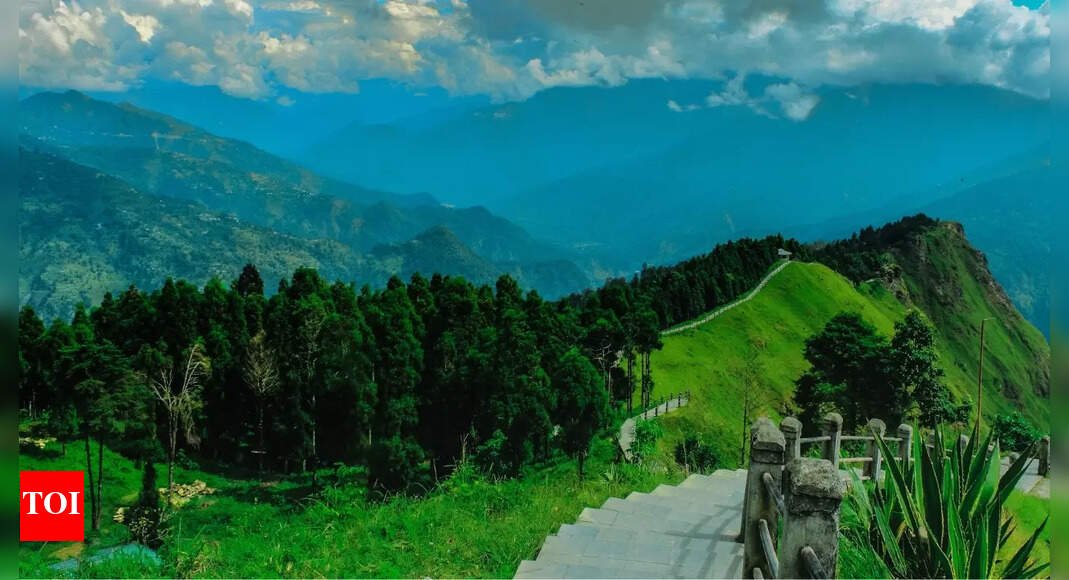Travel Guides & Articles
Sanjay Gandhi National Park Unveils the Revamped Van Rani Toy Train, Boosting Heritage Travel and Eco-Tourism Excitement Through Urban Wilderness in Mumbai’s Natural Haven, India

Saturday, July 19, 2025
Van Rani’s Return to Sanjay Gandhi National Park Sparks Global Eco-Tourism Aspirations
The eagerly awaited revival of the Van Rani toy train in Sanjay Gandhi National Park (SGNP), located in the heart of Mumbai, is being hailed as far more than a nostalgic reopening. With its deep roots in heritage and a fresh vision aligned with modern sustainability goals, this reimagined ride is expected to become a model for eco-tourism innovation that could inspire cities worldwide.
As global tourists increasingly seek purposeful, green, and heritage-based experiences, Van Rani’s comeback has begun to symbolize the kind of travel that appeals to today’s values: meaningful engagement, environmental consciousness, and cultural preservation. The blending of these elements into a single ride reflects a new kind of tourism—one that goes beyond sightseeing to foster learning and reconnection with nature.
Experts believe that this initiative has the potential to influence how other urban parks and conservation areas present themselves to travelers—transforming local attractions into global case studies for post-pandemic tourism recovery.
Reviving a Cherished Legacy with a Vision for the Future
The Van Rani, affectionately referred to as the “Queen of the Jungle”, has been a beloved fixture in Mumbai since 1974. Over the decades, this miniature train carved out a unique place in the hearts of locals, becoming a must-do ride for children, school groups, and nature lovers. For generations, it served as a gentle journey through SGNP’s rich biodiversity, sparking joy and curiosity along its scenic route.
However, in 2021, the ride was suspended after Cyclone Tauktae caused significant damage to its tracks and supporting infrastructure. With safety risks looming, the once-popular attraction had to shut down indefinitely. Now, after four years, the train is making a triumphant return—completely refurbished, upgraded, and realigned with environmental learning and sustainable tourism values.
Redesigned Experience Focused on Wildlife and Learning
This new version of Van Rani is no longer just about a fun ride through greenery. The experience has been transformed into an educational adventure, offering riders detailed insights into SGNP’s flora and fauna. Informational panels aboard the train will introduce passengers to native species, conservation stories, and the significance of the park’s ecosystem.
As the train winds through the park, passengers will be treated to stunning views of the Deer Park, lush vegetation, and a route designed to showcase the area’s environmental diversity. This approach is expected to captivate not just children but also curious travelers of all ages seeking to combine leisure with learning.
In this form, the train becomes more than a memory from the past—it becomes a mobile classroom, designed to nurture a stronger appreciation for urban wilderness and environmental stewardship.
Major Overhaul of Route and Infrastructure
In preparation for Van Rani’s return, a full-scale upgrade of its infrastructure has been carried out. The entire 2.3-kilometer track has been completely rebuilt, including the reconstruction of all 15 bridges to ensure smoother, safer rides.
A brand-new train unit has arrived, and trial runs began on June 30, 2025, followed by a successful full-capacity trial on July 5. These tests mark a critical phase in confirming the train’s readiness for public relaunch.
Two of the ride’s major stations have also been modernized:
- Krishnagiri Station has been upgraded with new platforms, improved buildings, and accessibility ramps to accommodate passengers with different mobility needs.
- Teenmurthy Station has undergone platform redevelopment, and the new station shed is set for completion by July 25.
These updates emphasize safety, inclusivity, and user convenience, making the ride not just enjoyable, but also accessible and dependable for all.
A Fusion of Heritage and Environmental Responsibility
While the restoration of Van Rani evokes strong feelings of nostalgia, its redesign clearly reflects a commitment to eco-conscious practices. The Van Rani 2.0 is being positioned as a benchmark for sustainable tourism, where green values blend seamlessly with historical preservation.
By including educational elements, reducing its environmental footprint, and highlighting local biodiversity, the train seeks to raise awareness while also creating joyful experiences. This blend of emotion and mission could influence other urban green spaces looking to rejuvenate their image through sustainable heritage tourism.
Planners and stakeholders have shared hopes that this revival will spark similar transformations in parks and reserves, especially in urban areas where the demand for accessible nature experiences is growing rapidly.
Mumbai’s Green Marvel Ready to Welcome the World
Sanjay Gandhi National Park, covering 106.95 square kilometers, is one of the largest national parks within a city anywhere in the world. With final preparations underway, the park is gearing up for a wave of visitors upon the train’s expected reopening in late July 2025.
This launch is expected to have wide-reaching impacts:
- Local tourism will likely receive a significant boost, especially as families and schools resume travel routines.
- Eco-tour itineraries involving Mumbai could now include SGNP as a major highlight.
- Urban travelers, both domestic and international, may increasingly prioritize parks like SGNP when choosing destinations with green, meaningful activities.
As more people seek open-air, educational, and sustainable travel experiences, Van Rani’s revival is well-timed to tap into this evolving market. It could also provide inspiration to other metro cities seeking ways to reconnect residents and visitors with nature.
What’s New in the Van Rani Experience
- Track Revamp: Complete 2.3-km route rebuilt, with all 15 bridges reconstructed for safety and reliability.
- New Train in Service: Arrived and tested successfully in late June and early July 2025.
- Station Upgrades: Krishnagiri Station enhanced with accessibility features; Teenmurthy Station set to finish by July 25.
- Wildlife Panels: Educational displays added to boost environmental awareness.
- Opening Date: The ride is expected to reopen to the public by the end of July 2025.
The return of Van Rani is not just about reliving the past—it’s about creating a future where heritage meets sustainability, and where nature becomes an integral part of urban travel. As travelers become more conscious of how they explore the world, attractions like this one—revived, redesigned, and repurposed—could lead the charge in reshaping global tourism norms. This beloved ride through the wild heart of Mumbai now carries a message much bigger than itself: that connection, conservation, and curiosity can—and should—ride together.
Travel Guides & Articles
India’s TBO to acquire Classic Vacations

India based travel distribution platform TBO has agreed to acquire Classic Vacations from Phoenix-based investment firm, The Najafi Companies.
The transaction value is estimated at up to $125 million.
The acquisition brings together TBO’s technology platform and worldwide inventory with Classic Vacations network of luxury travel advisors and suppliers.
Classic Vacations delivered revenue of $111 million and an operating EBITDA of $11.2 million in the fiscal year ended December 31, 2024.
“We’re thrilled to bring Classic Vacations into the TBO family – the company’s longstanding delivery of outstanding services has earned the trust of its more than 10,000 travel advisors in the U.S,” said Gaurav Bhatnagar, TBO’s co-founder and joint managing director.
“Classic Vacations is led by a strong team of experts and will continue as an independent brand.”
“As we start working on integrating Classic Vacations with TBO, we will remain open to similar strategic alliances going forward,” added Ankush Nijhawan, co-founder and co-managing director.
Melissa Krueger, CEO of Classic Vacations, added: “Together, we’re strengthening Classic Vacations’ position as the premier luxury partner in the market while extending our reach onto the global stage.”
Classic Vacations was bought by The Najafi Companies in 2021 from Expedia Group.
Classic Vacations has a large network of high-value travel advisors and deep ties with major American consortia.
It delivers premium service across hotels, air, experiences, car rentals, and travel protection, specializing in bespoke luxury itineraries.
Related News Stories: Partner News – TravelMole
Travel Guides & Articles
Govt allows select minorities to stay in India without passport

The Union Home Ministry on Monday, September 1, issued an order announcing that the government now exempts minority communities, namely, Hindu, Sikh, Buddhist, Jain, Parsi and Christian fleeing religious persecution from Afghanistan, Bangladesh, and Pakistan, who entered the country by December 31, 2024, without requiring valid passports or travel documents.
“A person belonging to a minority community in Afghanistan, Bangladesh and Pakistan, namely, Hindu, Sikh, Buddhist, Jain, Parsi and Christian, who was compelled to seek shelter in India due to religious persecution or fear of religious persecution and entered into India on or before the 31st December, 2024,” read the order from the home ministry.
Interestingly, the order did not name Muslims. This is in line with the BJP-led government’s Citizenship Amendment Act (CAA) that was passed in 2019 to facilitate this. It had le to severe protests from Muslims and other citizens who said the law is discriminatory in nature and that it can also be misused to disenfranchise Muslims in the country.
In fact, over the last few months the central government and BJP-led state governments have been targeting Indian Muslims from West Bengal who were being picked up on false allegations of being Bangladeshi citizens. Several prominent activists including Umar Khalid and Sharjeel Imam are currently in jail having spent nearly five years in prison on charges of inciting riots in Delhi amid the anti-CAA protests.
It was issued as part of a series of directives made public by the Union Home Ministry, under the newly enacted Immigration and Foreigners Act, 2025, which came into effect on Monday, September 1.
The Immigration and Foreigners Bill, 2025, aims to grant the Union government the power to control the entry and exit of individuals into and from India by regulations that outline requirements for travel documents, such as passports, and govern various aspects of foreign nationals’ stay, including visa rules, registration procedures, and other related matters.
Previously, the Citizenship Amendment Act (CAA), which was enforced last year, extended the eligibility for citizenship only to non-Muslim minorities from Afghanistan, Bangladesh, and Pakistan who entered India on or before December 31, 2014.
While the recent directive allows certain individuals to stay in India without documentation if they arrived by December 31, 2024, it doesn’t guarantee citizenship.
In contrast, the 2019 Citizenship Amendment Act offers a path to citizenship for persecuted non-Muslim minorities from Pakistan, Afghanistan, and Bangladesh who entered India before December 2014.
The CAA’s exclusion of Muslims sparked widespread protests and concerns about discrimination, secularism, and potential disenfranchisement.
Travel Guides & Articles
Greenest destinations in India for eco-conscious travellers |

India is a haven for eco-conscious travelers seeking sustainable travel experiences. From lush rainforests to pristine Himalayan valleys, these are the places where natural beauty and responsible tourism go hand in hand. Here is a list of India’s greenest escapes, ideal for travelers who wish to explore and make the most of the outdoors while minimizing their environmental impact.
Mawlynnong, Meghalaya
Known as Asia’s Cleanest Village, Mawlynnong in Meghalaya is a model of sustainable living. Look around you and you will find bamboo dustbins. People do not litter here and they expect the tourists also to respect the village’s ways and not litter. Plastic is banned here. Take out time to explore the living root bridges, and interact with the local community. There are eco-lodges and homestays where visitors can stay, these stays offer authentic experiences.
Thenmala, Kerala
This is India’s first planned eco-tourism destination, Thenmala in Kerala’s Western Ghats offers a sustainable escape amidst evergreen forests. Also known as “Honey Hill,” it features attractions like the Thenmala Dam, Butterfly Safari Park, and Shenduruney Wildlife Sanctuary. For those interested, there are activities like boating, trekking, and rock climbing.
Sikkim
The entire state of Sikkim is a beacon of eco-tourism. Sikkim is recognized for its organic farming and conservation efforts. No wonder, it is also India’s first fully organic state. Sikkim is home to the Khangchendzonga National Park, a UNESCO World Heritage Site, which also boasts diverse flora and fauna, including red pandas and snow leopards. There is no dearth of eco-friendly guesthouses, responsible trekking opportunities, and cultural immersion with Lepcha and Bhutia communities. And last but not least, Sikkim is very clean, thanks to the eco-conscious communities.
Munnar, Kerala
Munnar in Kerala’s Western Ghats, is known for its tea plantations, lush valleys, and biodiversity. It is where you will find the rare Neelakurinji flower and species like the Nilgiri Tahr. Munnar is a great place for those seeking romantic getaways, but it is equally perfect for those seeking adventure activities like trekking and wildlife watching. Eco-resorts and sustainable practices, like waste management and local sourcing, ensure a low environmental footprint.
Spiti Valley, Himachal Pradesh
Monsoon may not be the right time to visit Spiti Valley, but come drier months, Spiti is one of the best in the country. This cold desert in the Himalayas, balances tourism with ecological preservation. Solar-powered homestays and community-based tourism initiatives support local livelihoods while protecting the fragile ecosystem. Travelers can explore ancient monasteries, trek through rugged terrains, and engage with sustainable practices, making Spiti a unique eco-destination. Here, it’s all about green energy and sustainable practices, because the greenery that comes with nature is a bit rare here, thanks to it being a cold desert.
-

 Business5 days ago
Business5 days agoThe Guardian view on Trump and the Fed: independence is no substitute for accountability | Editorial
-
Tools & Platforms3 weeks ago
Building Trust in Military AI Starts with Opening the Black Box – War on the Rocks
-

 Ethics & Policy1 month ago
Ethics & Policy1 month agoSDAIA Supports Saudi Arabia’s Leadership in Shaping Global AI Ethics, Policy, and Research – وكالة الأنباء السعودية
-

 Events & Conferences4 months ago
Events & Conferences4 months agoJourney to 1000 models: Scaling Instagram’s recommendation system
-

 Jobs & Careers2 months ago
Jobs & Careers2 months agoMumbai-based Perplexity Alternative Has 60k+ Users Without Funding
-

 Education2 months ago
Education2 months agoVEX Robotics launches AI-powered classroom robotics system
-

 Funding & Business2 months ago
Funding & Business2 months agoKayak and Expedia race to build AI travel agents that turn social posts into itineraries
-

 Podcasts & Talks2 months ago
Podcasts & Talks2 months agoHappy 4th of July! 🎆 Made with Veo 3 in Gemini
-

 Podcasts & Talks2 months ago
Podcasts & Talks2 months agoOpenAI 🤝 @teamganassi
-

 Education2 months ago
Education2 months agoAERDF highlights the latest PreK-12 discoveries and inventions





















